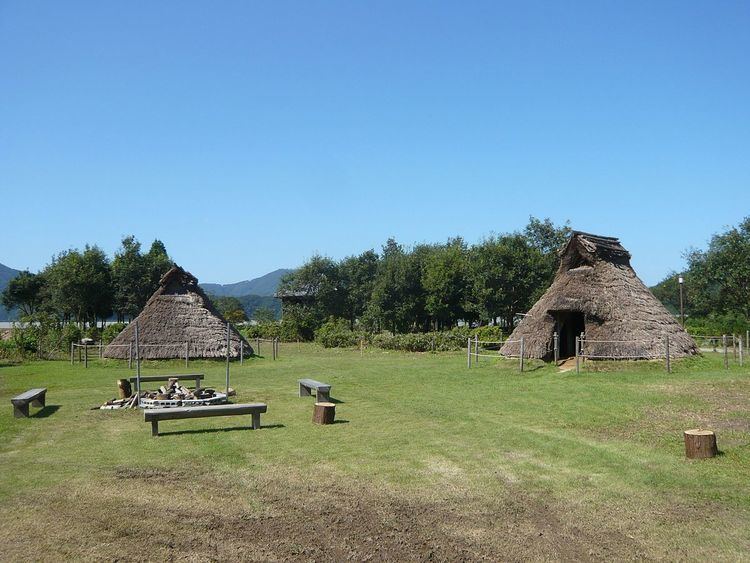 | ||
Torihama shell mound is an Early Jomon period settlement at Torihama in Fukui Prefecture, Japan. It is a waterlogged midden site that was occupied mainly from the Incipient Jomon period to the Early Jomon period from 12,000 to 5,000 years ago (10,000–3,000 BC).
Contents
The site is located in the area of 'Mikatagoko', the Mikata five lakes, near the confluence of Hasu and Takase Rivers. It was originally located south of Lake Mikata.
Excavations
The excavation of the site was initiated in 1962, and conducted up to 1972 by Doshisha Kyoto University, and Rikkyō Tokyo University. Starting in 1975, the Fukui Prefectural Education Committee continued the investigations. Important information about early agriculture in Japan in 7500-3500 BC was discovered.
Discoveries
The cultural deposits are about 6 to 3 meters thick. Primarily fresh water shells are found in the midden. Ropes, reed baskets and similar items were plentiful.
Very old stone weights used for nets were excavated, as well as many other items made of stone. A large quantity of stone axes were found.
The inhabitants hunted various local fauna. Skeletal remains of the Japanese wolf have been found at Torihama dating 10,000 to 250 B.C.
Cultivated plants
Evidence of early beefsteak plant perilla (Jap. 'egoma') was found. Other plants that were cultivated were bottle gourd, hemp (Cannabis sativa), paper mulberry (Broussonetia papyrifera), burdock, and mustard family plants (Brassicaceae). Weedy annuals and shrub fruits and nuts, such as acorns and walnuts, were also used by villagers. The latter comprised a very substantial part of the diet.
Chestnut (Castanea crenata Siebold & Zucc.) was also found, as well as water chestnut (trapa), and the regular sweet chestnut.
In terms of caloric intake, plant foods made up about half of the diet. Red beans (Adzuki beans), melon, and Chinese cabbage were also found.
Manufactured goods
Wood products of all kinds have been found, including lacquered pottery and combs. They represent the oldest known examples of Japanese lacquerware. The items were found by scholars from Tohoku University who investigated the site in 1984-2011, and they may date to 12,600 years ago.
Also found here was the oldest fabric product yet found in Japan—a rope made of hemp, dating back 12,000 years. Also, a woven item made of Boehmeria tricuspis, a vegetable fiber, was found.
Canoes
The 1981 excavation revealed the presence of some very old dugout canoes at the site; the oldest one was dated 5500 BP. This was the oldest canoe found in Japan. It is about 6 meters long, and made from the Japanese cedar tree. Burning was used in its manufacture, as well as adzes.
The majority of remains unearthed from the Torihama site are stored and exhibited at the Wakasa History and Folklore Museum in Obama City (c. 20 km west of the site).
